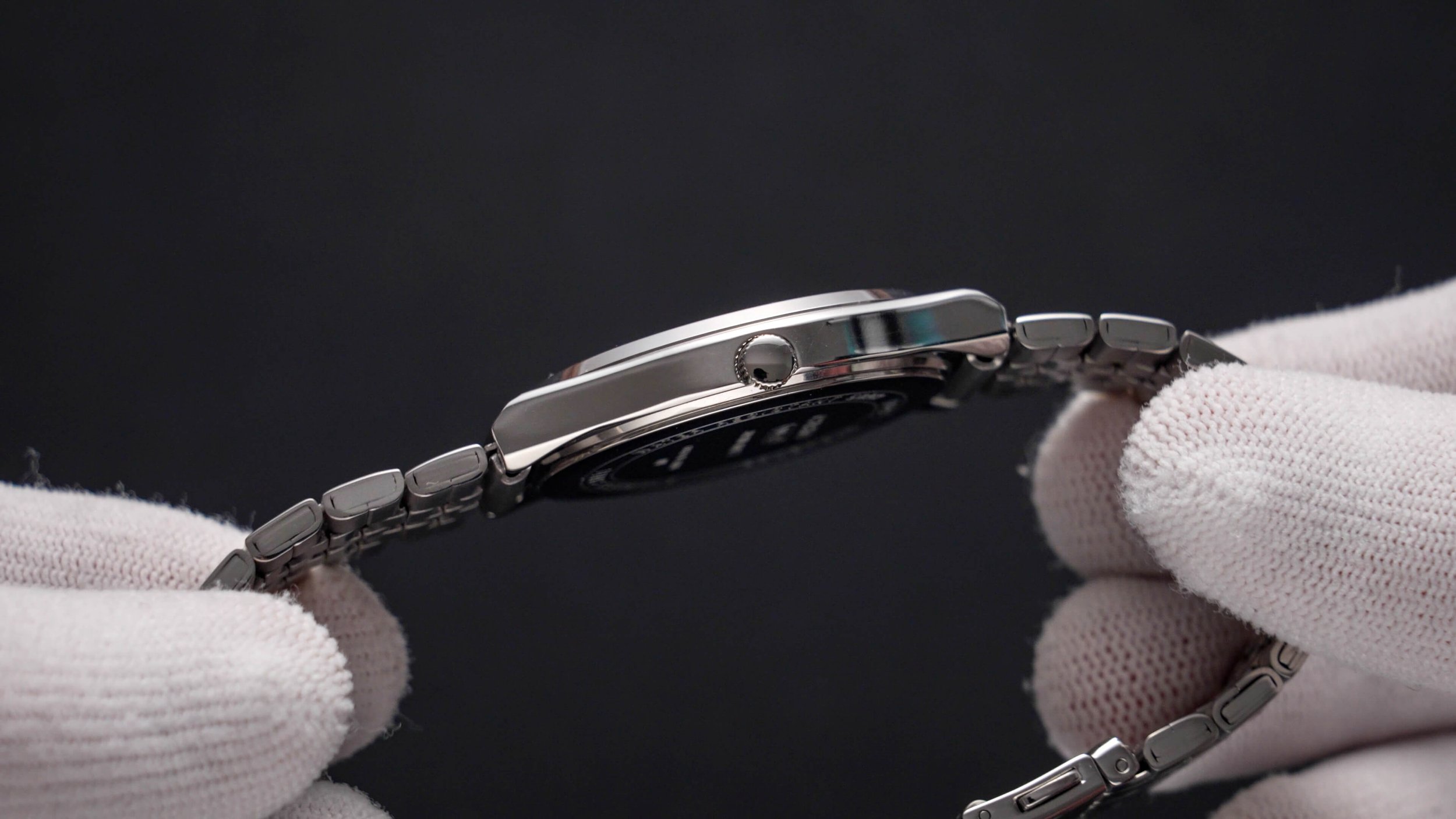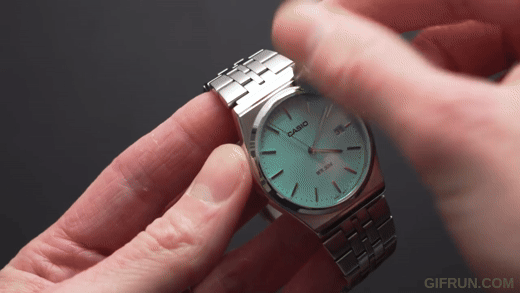Is This Dirt-Cheap Casio Really a PRX-Killer? - Casio MTP-B145D Review
(This page features affiliate links, for more information, click here.)
A few months ago, I warned against buying the super-viral Casio Tiffany watch. The reason? Well, despite being a Casio, that watch was made of low-end chromed brass rather than the industry-standard stainless steel that many outlets were claiming, meaning it looked and felt pretty cheap, with a questionable level of durability. Crucially, the turquoise version retailed for almost double the other models, with scalpers buying them en masse and flipping them for nearly 500 bucks. All in all, it looked cool but had some obvious drawbacks for those who cared even an ounce about quality.
Casio MTP-B145D Review
Introducing the new MTP-B145D. It’s the latest ‘Tiffany’ blue watch from Casio, and unlike the previous one, this one is actually made of stainless steel...or at least it’s supposed to be. While the last one was more of a Rolex Datejust clone, this one clearly takes inspiration from the much-loved Tissot PRX, with a similar case shape, handset, and dial layout…or so I thought.
You see, when I checked to see if this really was a copy-and-paste job, I discovered I may have been wrong. Indeed, the Casio webpage for this watch dates back to 2018. Now, I think what’s happened here is that one or two versions of this model have been available for several years (blue and white), and Casio recently added some extra colors (turquoise and pink) to jump on the Tiffany hype train. The PRX itself is based on a 70s model that easily predates the 2018 Casio, even with a similar hooded-lug design, but the angular case shape is quite different. So, I’d say it’s more of a half-copy overall.
Dimensions
If anything, the MTP-B145 is most comparable to the smaller 35mm PRX models, as it has an identical case width and a similar 40mm lug-to-lug length.
Perhaps the most notable visual difference is the thickness. This case is wafer thin, at only 7.5mm, with virtually no taper, giving a pancake-like appearance that may be a hindrance if the watch were any larger. Thankfully, the compact sizing mostly prevents this issue, though a scaled-up future model would probably need some tweaks.
Case Construction
For the most part, the case has quite soft corners and a particularly shiny finish that doesn’t look like your average stainless steel watch. In fact, despite saying stainless steel on the snapback rear, it looks suspiciously like their silver resin watches, such as the A158 and A168 digitals. When I unboxed these on my unboxing channel, “In The Loupe”, I immediately suspected they were plastic or some sort of lower-grade metal due to the extremely lightweight feel and the unusual surface temperature. For some reason, these steel cases are rarely cold to the touch; they’re often warm, unlike the other 99% of steel watches I’ve tried to date. In contrast, the steel bracelets fitted to these same watches are usually cold.
I purchased these several months ago, when an eBay watch dealer was the only place selling them, so I messaged them to confirm the case material. They said it was stainless steel. I then double-checked with Casio Japan, who confirmed that it was steel in all sales regions. That should settle it, right?
Well, I wasn’t totally convinced. Viewers encouraged me to try using a magnet, and the behavior I observed was intriguing. You see, this mini magnet had no trouble sticking to steel objects around the house and even attracted to the bracelet and caseback of the B145. Those two parts should be steel, as they typically are, even on some of their cheapest watches. Yet, the magnet wouldn’t adhere to the main body of the watch. It toppled off the upper portion every time, and when I tried to attach it to the flanks, it snapped to the rear instead.
Either way, these are currently selling on the Casio UK website for £65, or the equivalent of $82 US Dollars, and the fact that I’m even questioning the case material shows they are far from the most substantial-feeling watches you can get for that price. That’s even with inflation! It weighs just 67 grams, which can be partially attributed to the flimsy bracelet, which isn’t far from those on their much cheaper digitals. This means the watch is pretty comfortable from a weight perspective, though your arm hairs may not feel quite so appreciative.
Nevertheless, even at this elevated cost, most buyers probably still care more about aesthetics than quality. If the watch looks good, they can forego some cost-cutting construction.
Dial Design
In a fashion watch role, I’d say the MTP-B145 does a commendable job. While small for most male wrists, it looks sporty and sleek, especially in the newer, brighter colors. One of the improvements here versus the previous Casio Tiffany (aside from the debatable case material) is the dial surface. Rather than the run-of-the-mill flat appearance of the last one, the B145 has a much more vibrant finish, with a reasonable sunburst effect that catches the light much more effectively.
I got suckered in by the salmon pink one in particular, which I think looks even better with a cleaner, stronger sunburst, though I must say that in person, this pink isn’t nearly as saturated as in the edited stock images. I’m unsure if this subtler coloring is better or worse, so I’ll let you be the judge on that one.
Outside of the shiny colors, the rest of the dial is your typical clean, minimalist design, with slim, lume-free hands and markers combined with a limited amount of text. While simplistic, I’d say it is still very attractive and well-balanced, if not remarkable. Above the dial is a piece of bog-standard mineral crystal, which provides reasonable scratch resistance and at least doesn’t induce any distracting reflections.
Movement & Water Resistance
The incredible thinness helps the B145 wear very flush to the wrist, so long sleeves won’t pose any challenge either. As you can guess, they’ve used a battery-powered movement to achieve this slimness. Within is just a basic Miyota quartz like many other cheap modern Casios. One unit is aligned well with the second markers; the other isn’t.
Water resistance is fairly decent for a watch of this style, at fifty meters, meaning day-to-day aquatic encounters won’t be an issue. In watchmaking, fifty meters isn’t technically as good as it sounds, but even then, short durations of submergence should be okay.
Bracelet
While water isn’t a major issue, getting the watch to fit comfortably may be more challenging. The bracelet has a push-button clasp featuring no micro-adjustment holes for fine tinkering. This means, that when customizing the fit, you can only do so by extracting whole links at a time. Mercifully, the links themselves are small, but the range of adjustment still isn’t as forgiving as other watches with more traditional clasps…cost cutting taken too far in my books.
Visually, at least, this bracelet suits the look quite well, with a reasonably executed brushed finish on top and a polished appearance on the sides, mirroring that of the case. I’d say the folded link construction is a tad better than that on some dirt-cheap Casios, but it maintains a jangly feeling nonetheless. Thankfully, you can switch this out for any other 18mm strap, unlike some alternative budget PRX clones. You get somewhat of an integrated bracelet look without the main downside.
Case Material
Of course, a much worse downside would be if the case material was mis-sold.
Following my recent scratch test video, I emailed Casio a second time to see if it was perhaps a different grade of steel. Casio Japan replied with an interesting revelation. The representative informed me that the case, rear, and bracelet were all made of SUS304, the Japanese designation for Type 304 Stainless Steel.
Opportunely, the Vostok we scratched in our test video was made of that same grade, making for a perfect comparison. While side by side, the appearance and tone are very similar, and they even share a comparable glossy finish with notably soft edges and corners. I won’t be testing the Vostok case with the magnet, as it’s currently up for auction; I can’t risk magnetizing the automatic movement for the new owner. That said, the excess bracelet links are much more attracted to the magnet than the Casio case was, for whatever weight that holds.
As a quick reminder, the 304 steel Vostok started scratching lightly at level 5, with more noticeable grooves at level 6, mostly the same as the industry standard 316L steel.
So how does this Casio compare?
Well, I’m pleased to tell you that despite the misleading first impression and atypical case characteristics, it is most likely made of 304 steel. It showed no marks at level 4, then scratched lightly at level 5, with deeper grooves at level 6; just like the Vostok.
While it’s not the standard steel used in watches, it is adequate for a budget watch and is better than the chromed brass used in the previous Casio Tiffany watch. This doesn’t explain why the magnetism was so inconsistent across different parts of the watch, nor why it felt warmer than expected, though I expect it’s something to do with either the manufacturing techniques, the finishing, or the thickness of the metal. After all, this skinny design is very different than the bulbous Vostok. I wonder if the imprecise edges present on both watches are more down to cost-saving measures than the use of 304 steel; I’d love to hear from you metal nerds in the comments.
Final Thoughts
So, I was onto something. The case material wasn’t 316L steel, but I’m glad my initial assessment was still proven wrong. This watch should still survive relatively well. At its current UK retail price, you can purchase many better-made watches from Casio or other lesser-known brands. Despite this, there’s very little integrated (or faux-integrated) sports watch competition in this segment, meaning Casio can pretty much ask what they want for this watch. Most of the Chinese PRX clones on AliExpress are either rubbish quality or start at £80, not including shipping or additional taxes.
Most microbrands seem stuck to the playbook of a super high-finish watch with a Seiko NH35 or Miyota automatic inside. I’d love to see more challengers in this lower-end space because as good-looking as this watch is, I think it can be beaten.
















